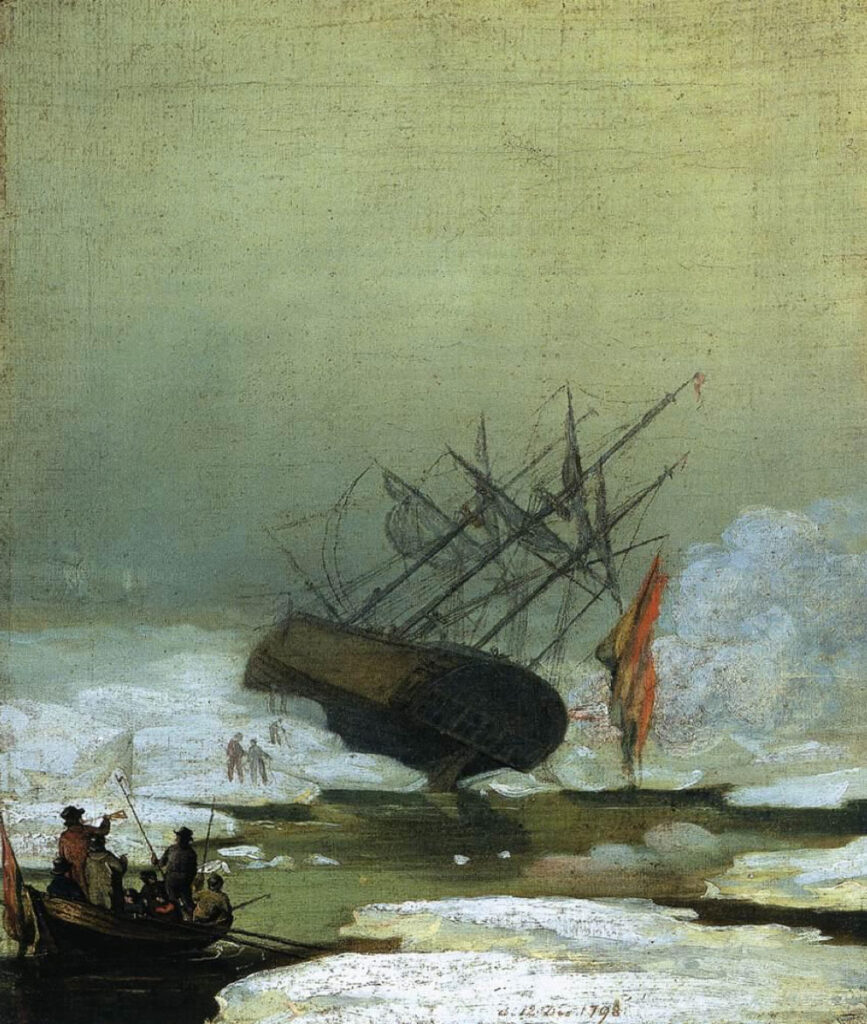
William Bradford (1823-92)
Trapped in Packed Ice, 1877
Oil on canvas, McMullen Museum of Art, Boston College, Carolyn A. and Peter S. Lynch Collection, 2022.47

Jeffery Howe
Professor Emeritus, Art History

Trapped in Packed Ice is a dramatic illustration of the dangers of Arctic exploration. Pack ice often trapped and crushed ships. In 1871, thirty-three whaling ships, many from New England, were trapped and destroyed by pack ice off the Alaska coast. The motif of the “storm-tossed boat” was a key symbol of the perils of the “voyage of life” from the Romantic era onward, as seen in haunting images by the German painter Caspar David Friedrich (1774–1840). The delicate structure of the masts and rigging is juxtaposed with the implacable solidity of the massive icebergs. The small forms of the sailors on the ice remind the viewer of the fragility of humans who have tested themselves against the sublime power of nature.

Ethan Baxter
Professor, Earth & Environmental Sciences

Viewed in the context of climate change, Bradford’s paintings depicting the frozen polar regions from one hundred fifty years ago conjure up feelings of anxiety and reminiscence in a geoscientist. Anxiety, because such Arctic scenes have already become far less pervasive than they were in Bradford’s time and point to a troubling climate future that is upon us. Reminiscence, because those icy scenes may someday be gone forever, preserved now only in memories, illustrations, and paintings like this and his Among the Ice Floes nearby. Every September, Arctic sea ice melts and reaches its annual minimum extent. Warming climates have reduced the areal coverage and thickness of Arctic sea ice by about 60 percent since 1878 when Bradford painted these (see figures 1a, 1b), and all of that reduction has occurred since c. 1970. At its present rate of decline, summer Arctic sea ice will be completely gone sometime in the latter half of this century. While the opening of shipping lanes in the Arctic might seem attractive to mariners like the souls pictured in Bradford’s works (like the fabled Northwest Passage that opened for the first time in 2012, see figure 1c), the accompanying consequences of global warming will far outweigh this apparent benefit. Ice, a majestic blue-tinted rock in its own right, is slowly fading from the surface of planet Earth for the first time in human history. Bradford’s painting captures its story.

Christy Pottroff
Professor, English

Arctic expeditions—like those depicted in this painting and Among the Ice Floes by William Bradford—were exercises in extremity. Driven toward the impossibly remote landscapes of the Arctic Circle, sailors endured extreme temperatures and traversed a harsh and unfamiliar ecosystem where the sun shines constantly in the summer and darkness falls for months every winter.
Hundreds of ships sought the perils of the ice over the course of the nineteenth century—to scout out and forge faster trade routes through the Arctic Circle. Most ships carried about fifty men, traveled in small fleets, and were provisioned for voyages of two to three years. Many were funded by European national governments, who imagined themselves to be building the infrastructure for global trade—through the icy ends of the Earth.
Within this world of extremes sits American painter William Bradford, cold—shivering, despite his layers of winter wear—sketching, drafting, and painting in subzero temperatures. This work captures the domineering, ice-chiseled landscape of the Arctic, where icebergs tower over ships, rendering sailors miniscule by comparison. Bradford’s brush also elaborates the eerie and uncanny light of the North for his viewers: Trapped in Packed Ice pronounces a dramatic interplay of white, gray, and blue on what must have been one of the sunniest days of his expedition. Light was scarce in the Arctic; Bradford’s brush finds it, pulls it from the frozen context, and works against the elements to preserve its effect in scenes on canvas.
In some respects, the Arctic expeditions of the nineteenth century were failures—the ice-bound passage was not a viable trade route, thousands of human lives were lost seeking it out, and the expeditionary and capitalistic values that charted the paths of these ships continue to be driving forces of climate change. These paintings by Bradford are some of the greatest successes of the expeditions (along with the travel narratives, ship-made newspapers, and other testaments to human fortitude under extreme environmental conditions). Bradford’s paintings attest to the formidable and otherworldly nature of the Arctic as it was in the nineteenth century—and inspire respect for a landscape that faces the greatest threat to climate change today.
For a nonfiction study of a broad range of polar media, read Hester Blum’s The News at the End of the Earth. For Antarctic fiction, pair Edgar Allan Poe’s only novel The Narrative of Arthur Gordon Pym of Nantucket and its haunting and unfinished ending, protagonist adrift near the South Pole—with Mat Johnson’s satirical fantasy Pym, a modern retelling that traverses the same geographical extremes to explore enduring questions of race and racism in the American imagination.
